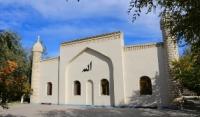You are here
Old Beineu necropolis.

Necropolises of Kazakhstan.
“But the time has come for him to go to another world.
He said goodbye and left this land.
I got to know the school with him, and was seething, and overflowing with heat.
I grasped the essence by reading in the Quran:
"Verily, Allah will give you a real victory"
Hikmets Khoja Ahmed Yasavi.
Travel at its most relaxed Mangistau.
The necropolis of Old Beineu is located 13.1 kilometers southeast of the Dead Kultuk salt marsh, 22.9 kilometers west and slightly south of the Sangyrlau village, 16.4 kilometers southwest of the district center of the Beineu village, 2, 5 kilometers southwest of the Aktau - Beineu highway in the Beineu district in the east of the Mangistau region.
The historical settlement of Beyneu consists of archaeological remains of the wintering grounds of nomadic pastoralists. Old Beyneu is a small settlement, which until recently consisted of several mud-adobe houses of shepherds, located in the place where the ancient caravan route leading to the lower reaches of the Emba River rises to Ustyurt.
There is a spring here, to which the settlement and the ancient necropolis owe their origin. After a difficult passage through the Caspian salt-marsh desert, travelers stopped at this blessed relative.
It is possible that there was also a caravanserai here, but no traces of it have been found.
To the southwest of the spring and the shepherds' houses there is a vast necropolis, divided by the channels of two ravines into two halves. The ancient part of the necropolis is located behind the second, western part, most of its monuments are heavily destroyed small forms of gravestones and a group of late saganatams of the XXth century.
The second half of the necropolis is located on a high promontory formed by the gentle slopes of two ravines. The monuments of this part of the necropolis are better preserved and can be roughly dated to the XVIth - XIXth centuries.
According to folk legend and fragmentary information from written sources, throughout the Middle Ages, Oguzes, Kipchaks, Nogai, Bashkirs, Turkmens and tribal groups of Kazakhs - Adai, Tama, Tabyny, Kete, Serkeshi, Bersh and others roamed here in shifts, as well as in the first third of the XVIIIth century.
Consequently, the most ancient tombstones of the Beineu necropolis could have been built by the Oguz-Kipchak and Kipchak-Nogai tribes. Due to the strong destruction, it is practically impossible to determine the time of their construction and ethnic belonging, with the exception of one ancient koitas with the Kipchak tamga “II - Kosalif”.
Most of the well-preserved monuments dating from the middle of the 18th - the beginning of the XXth centuries have generic tamgas. The northeastern part of the necropolis, where the more ancient monuments are mainly concentrated, is divided by ravine channels into two parts.
There are monuments of the XVIIth - XXth centuries, which are represented by several mausoleums, saganatams and many small architecture, koitases, kulpytases, sandyktases, stone pyramids.
In total, about five hundred monuments have been preserved in the ancient part of the necropolis.
Most of the necropolis consists of modern structures from the second half of the 20th century.
Geographic coordinates of the Old Beineu necropolis: N45 ° 11'07.62 "E55 ° 06'22.43"
Authority:
«Monuments of the Central Asia». The author of M. Khahsimov. Publishing house, Saga, 2001
Alexander Petrov
photos by.







